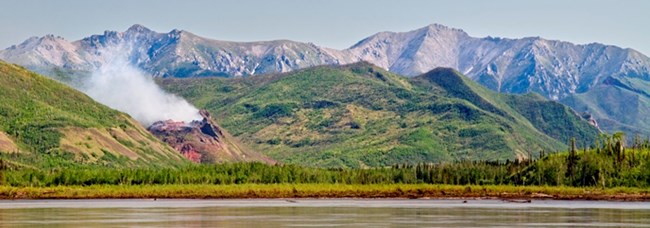
NPS/Greg Kinman 
NPS/Greg Kinman 
NPS/Greg Kinman 
NPS/Greg Kinman Further downriver, around fifty miles from Eagle by boat, near the Charley River's confluence into the Yukon, the river traveler encounters a view of the uplands of the preserve and the mountains that line the Charley as it flows north. It's an absolutely beautiful section of the river, and it's rich with natural history such as geological structures, fossils, and rare plant species - as well as grizzly bears! We saw a sow and her two cubs on a bluff near water level as we rounded one turn; the three of them bolted into the brush the second they saw us. It was nice to have my first wild bear sighting occur while I was inside a speedy motorboat! Near the end of the preserve boundary, the river is rich with geological material. Each bluff's structure is unique, and they all exude the sense of being walled into the river, as if the river wants its travelers to float all the way west, across the entire state, to the Bering Sea. 
NPS/Greg Kinman We arrived in the evening at Slaven's Roadhouse, a nearly 100-year-old two-story public-use cabin located on the river left bank of the Yukon, about 100 miles downriver from Eagle. One of the preserve's interpretive rangers, Randy, was stationed there, as is the norm during summer when the river sees a high number of visitors enjoying float trips. We stayed the night at the roadhouse for probably half the nights during the trip; the roadhouse is a good jump-off point for most river excursions, and we had the luxury of a motorboat, which allowed us to speedily travel both upriver and down. There's an ATV trail leading from the roadhouse to an old gold mining camp four miles away, except during our stay the trail was blocked by damming beavers at a creek crossing! The beavers were not skittish; they were fine with us watching them build. 
NPS/Greg Kinman The camp supported the Coal Creek Dredge, a historic gold mining dredge in operation from the 1930's through the 1970's in the preserve. Huge mounds of gravel that the dredge chewed up, sucked the gold out of, and spat back out line the Coal Creek drainage area. The entire Coal Creek drainage is littered with all manner of gorgeous, colorful wildflowers in summer. They are usually teeming with bees, who are so thrilled with the pollen harvest that they don't usually notice humans - the mosquito is the more troublesome flying insect in Interior Alaska. I am absolutely amazed at the grandiosity, the variety of life, and structure that is present in the Yukon River corridor. It's my hope that my images will spur people to come to the area to enjoy and protect this rich environment; it's worth seeing, and it's worth keeping, for sure. |
Last updated: July 15, 2020
